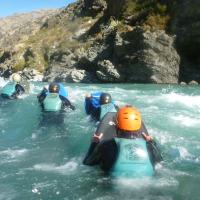Lake Wakatipu

Lake Wakatipu is the third largest lake in New Zealand and at 84 km long, it’s also the longest. Its name comes from Maori, Whakatipu wai-māori, which could mean “growing bay” or “bay of spirits”, depending on the translation of the historic Southern dialect.
The Z-shaped lake was carved out by a glacier more than 15,000 years ago during the last ice age. It’s a magical lake with its own ‘heartbeat’ – the lake rises and falls by about 20cm every 27 minutes. The best place to see this is at Bob’s Cove.
The phenomenon is a lake seiche, or ‘standing wave’. A combination of the mountains, which rise dramatically out of the lake, wind and atmospheric pressures causes the water to sway back and forth.
Legend of Lake Wakatipu
 Maori legend has a more colourful explanation for the seiche.
Maori legend has a more colourful explanation for the seiche.
Manata was the beautiful and talented daughter of a local Maori chief. Many men wanted to marry her, but she fell in love with a commoner, Matakauri. Thinking Matakauri was not good enough for his daughter, the chief forbade their marriage.
One day, a terrible giant known as Matau kidnapped Manata and tied her up in a mountain cave. Her distraught father promised she could marry whoever rescued her. Here was the clever Matakauri's chance. Knowing the warm nor-wester wind would put the giant to sleep, he followed the wind to Matau's lair in the mountains. While Matau was sleeping, he desperately tried to cut the cords that bound Manata, but they were too strong to cut. Fearing he would be killed, Manata begged Matakauri to leave before the giant woke up. Matakauri refused to leave her and Manata began to cry; the love in her tears magically melted away the cords and they both escaped.
On their return the couple married, but they both knew the giant would one day return. So Matakauri again followed the nor-wester to find the giant and set fire to his bed. Fat from Matau's giant body made a fire so intense it burned a hole more than 400 metres deep and the snow melted to create Lake Wakatipu. However, the giant’s heart survived the fire and it still beats, hidden underneath pigeon island, causing the water to rise and fall.
Look closely at the lake on a map and you’ll see it has the shape of a fallen giant. Queenstown is nestled at his knee, while Glenorchy lies at his head and Kingston at his feet.

First Sailing
Lake Wakatipu was first sailed in August 1859, by Scottish surveyor Donald Hay. He found a reed raft where Kingston now stands, fashioned a mast and nailed up his grey wool blanket as a sail. Pummelled by snow and winter's harsh wind Hay explored Lake Wakatipu's shores for two weeks in search of potential farm land. Finding a suitable section, he returned to Kingston and walked the 225kms to Dunedin - only to find a speculator had already beaten him to the land's lease.
Explore Lake Wakatipu today
You don’t need a blanket and a reed raft to explore Lake Wakatipu today. There’s plenty of ways to enjoy the water, from paddle boarding to kayaking. Make sure you wear a lifejacket and if you go for a swim, be prepared for very cold temperatures (8 – 10 degrees Celsius), even in the warmer months.
Alternatively, let someone else do the driving/sailing and take a cruise, whizz across the lake on a jet boat or enjoy a spot of fishing.



